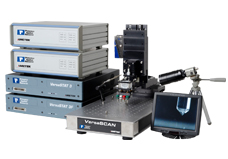SECM Overview
The SECM integrates a positioning system, a bipotentiostat, and an ultramicroelectrode tip. The positioning system moves the tip close to the surface of the sample. The bipotentiostat polarizes both the sample and the tip independently and measures both resulting currents. The tip is an ultramicroelectrode with a specific tapered polish and active radius lower than 100 microns. The positioning system scans the measurement tip and charts position with measured electrochemical parameters, creating a data map of local current.
Approach Curves are used as an electrochemical means by which to position the probe in Z sufficiently close to the sample to be in the local imaging zone. Current at the tip is charted as the tip is incremented towards the sample. When the probe is sufficiently close to the sample (a distance of 2-4 times that of the probe diameter) the measured current at the tip transitions from a bulk response to a local response. Over a region of high conductivity, a Nerstain response provides a local current enhanced over that of the bulk current. However, local current is decreased relative to bulk value over areas of low conductivity of the sample as mass-transport is hindered to the tip.
A common experiment in SECM is Generator-Collector Mode. Here one channel of the bipotentiostat polarizes the sample; where the other channel polarizes the tip. Similar to a Rotating – Ring Disk Electrode (RRDE) experiment, one electrode generates an electrochemical reaction, the products of which are subsequently measured at the other electrode. A SECM does this while adding the extra dimension of spatial resolution to the data, and being able to change from Sample Generation – Tip Collection (SG-TC) to Tip Generation –Sample Collection (TG-SC) often by simply changing polarization levels.
Since the imaging mechanism is electrochemistry, the applications of a SECM are as varied as the applications of electrochemistry itself. Some key applications are biological sensors, reaction kinetics, porous membrane study, fuel cell catalysts, and corrosion mechanisms.
The VersaSCAN SECM integrates the Base with two VersaSTAT Potentiostats and an ultramicroelectrode probe with a specific tapered polish. SECM is a versatile technique adding spatial resolution to applications such as kinetics, biological sensors, catalyst, and corrosion mechanisms.
.
-
Compatible Potentiostats: VersaSTAT 3F and either a VersaSTAT 3 / 3F /4
-
Capable of Approach Curves experiments and both Feedback Mode and Generator-Collector Mode imaging modes
-
Can perform Constant-Distance operation in conjunction with a topographic measurement technique, typically OSP
-
VersaSTATs are additionally capable of a vast suite of standard non-scanning electrochemical tests depending on their specific software model




















